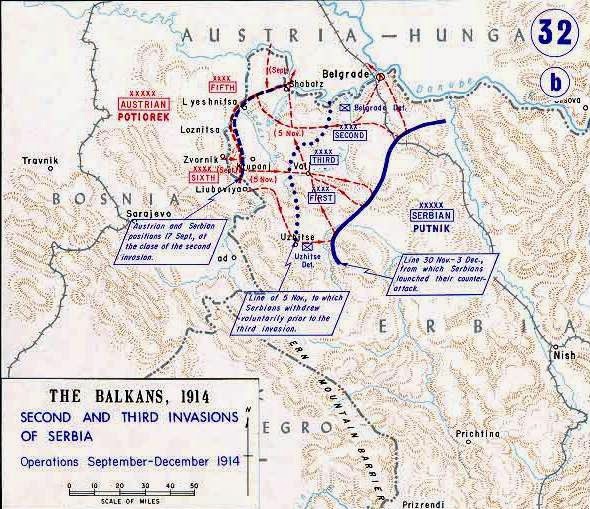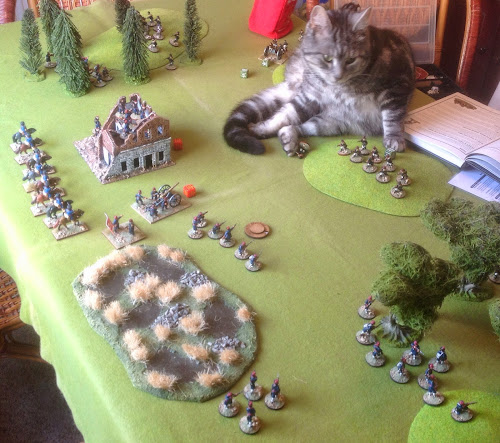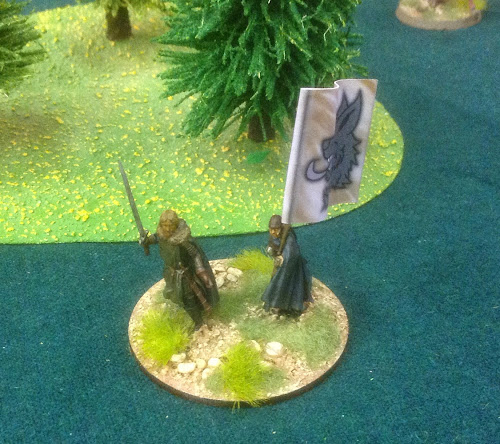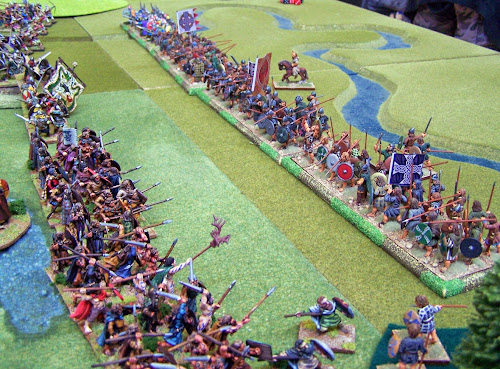Welcome to my blog!
or on Mastodon @balkandave@mastodon.scot, or Threads @davewatson1683
Sunday, 7 December 2014
Battle of Kolubara - December 1914
Tuesday, 25 November 2014
19th Century skirmish wargames
I have been looking for a set of rules to play skirmish games of up to around 50 figures a side. This is primarily for the Russo Turkish War of 1877.
I have now tested two options, Bolt Action and Terrible Swift Sword.
Bolt Action may seem a bit out of the time line, but I have played WW1 games very successfully with these rules. The basic mechanisms are very elegant and has the advantage that I and other gaming partners can pick them up and play quickly. In the trial game I made a few changes, such as shortening the rifle range, but it certainly played very well. If I go with this, I will need to think up some national characteristics and tweak the weapons to reflect important differences between the Russian and Turkish armies.
Terrible Swift Sword is a Sharpe Practice variant for the Amercian Civil War. I'm not a huge fan of card driven games, but the fun narrative behind Sharpe Practice won me over and we have had some really good games. The trial game didn't really work as it is too period specific. Russians and Turks don't really fit the U.S. cards that are the key to the game.
On balance I think I will go with Bolt Action, but not ruling out doing some cards for TSW and giving it another go when I have more time.
Here are a few pictures of the game. Three ten man infantry squads a side, together with a cavalry troop and light artillery.
And finally, when the Turks looked as if they might have the upper hand, our cat Rasputin intervened. At least he recognised which side he was supposed be on, positioning himself in the Russian lines. However, you might note a bit of 'blue on blue' - c'est la guerre!
Sunday, 23 November 2014
Chaldiran 1514
Sunday, 16 November 2014
The Empty Throne
This is Book 8 in the Warrior Chronicles set in Anglo Saxon England, featuring our hero Uhtred of Bebbanburg.
The historical context is the death of the Mercian ruler, with no legitimate heir. His wife is the obvious choice, but women rulers were rare, to put it mildly. Uhtred is wounded and a sub plot is his journey to recover the sword that wounded him. While the 'English' are divided the Vikings step up their raids on the west coast from Ireland. As usual the book ends with a grand battle, this time on the walls of Chester.
I am frankly running out of superlatives to describe Bernard Cornwell's writing. It is simply a book that you can't put down - the very best in historical fiction.
Sunday, 9 November 2014
WW1 Serbian Boys
Tuesday, 28 October 2014
Dystopian Wars - Ottoman Empire
Tuesday, 21 October 2014
Game of Thrones - House Stark
My painting schedule has drifted off in the last month. Busy at work and I have spent my spare evenings rebuilding the Glasgow and District Wargaming Society website. I am very pleased with the result. Please give it a visit and if you do Facebook and Twitter give us a follow there as well. I have used Weebly for this site and I am very impressed with the software.
What painting I have done is to complete my Saga Game of Thrones army for House Stark.
Ed Stark commands this force, with a figure from the Dark Sword range. A bit big for 28mm, but you can get away with this for a command figure.
The Stark and Lannister armies got their first run out on Sunday at the club. The Starks won and so Ed still has his head!
Sunday, 19 October 2014
The Long Turkish War
Friday, 10 October 2014
Hannibal: Clouds of War
It follows two unlikely friends, one a Roman and the other a Carthaginian, as they fight in the Second Punic War. The last book ended in the Battle of Cannae and the surviving legions are dispatched to Sicily. Inevitably our Carthaginian hero is also dispatched there by Hannibal to support their ally Syracuse. The book ends with Roman siege and of course the main characters meet up, albeit briefly.
I thought I knew quite a bit about the Punic wars, the Carthaginians were my first wargames army. I also associate the Sicily theatre more with the First Punic War. So I found the historical context interesting.
As with Ben Kane's other books, there is a close attention to historical detail without it slowing up the pace of book. It has all the elements you look for in the best historical fiction. The history, action, treachery and the personal interaction. Recommended.
Saturday, 4 October 2014
Somerled and the Battle of Renfrew
I attended the Somerled and the Battle of Renfrew conference today, held in the fine setting of Renfrew Town Hall. For those not familiar with Scottish town halls, many were built in the baronial style, and Renfrew is a particularly fine example.
My particular interest in this local battle goes back to a GDWS display game in 2011, Somerled's Last Stand.
Somerled, King of Argyll and Lord of the Isles died at the Battle of Renfrew otherwise called, Bargarran, Knock or Inchinnan in 1164. His Islesmen, Manx and Irish allies were defeated by a Norman/Scots army led by the High Steward, Walter Fitz-Alan. We actually know very little about the battle or the forces involved, so the game was somewhat conjectural.
The first session by Ted Cowan gave us some background to the period and, for me at least, confirmation that we have very few sources. Then Denis Rixson reviewed the evidence of the West Highland galleys that were an essential element of the armed forces of the isles. Birlinns were smaller versions of the classic Viking longship, more suited to the economy and warfare of the isles. He has a new book out on the subject.
The main primary source for the battle is a later poem, 'The Song of the Death of Somerled and the Sacking of Glasgow'. Dr Alex Woolf has a paper analysing the poem and what little it tells us about the battle.
In the lunch break we had an excellent original musical interlude from the Renfrewshire Youth Music Initiative. A haunting tune that beautifully captures the battle.
In the afternoon David Caldwell talked about Somerled and the Lordship of the Isles. Again, we have limited sources. It is likely that he came from Ireland in about 1130 to lead a brilliant campaign to recapture Argyll from the Norse and eventually became King of Argyll. David outlined the likely strongpoints and administrative structures.
Derek Alexander gave us an archeologists perspective with a description of what the area looked like in the 12C and an overview of the key players. The favourite site is on the Knock, Kemp Howe in Moor Park housing estate, but no real hard evidence. What we do know is that the victory enabled the Steward's to expand across the west of Scotland.
Really interesting day, pulling together what little we know about a little known battle that had important consequences for the development of Scotland.
Saturday, 20 September 2014
Game of Thrones - House Stark
I decided to use GW Lord of the Rings figures again, this time Riders of Rohan seemed the closest fit for House Stark. I know some war gamers regard GW as the evil empire, and it has to be said their figures don't come cheap. However, they are well sculpted and unlike a lot of historical plastics they fit together well with properly designed lugs etc.
I decided to go with the grunge look for the Stark's as in the TV series. The Direwolf shield transfers are again from Vini Vidi Vici. I have some banners from Flags of War, which i'll use with the command figures that are the next paint job
These are the hearthguard.
and these are a unit of mounted warriors.
I am thinking of starting a new blog on the perils of wargamers with cats. I left these outside while I got my iPad for the photos and came back to find the cat on top of them. Much glue required for repairs. More Grrrr from me rather than Meow!
Saturday, 13 September 2014
Dividing the Spoils of Alexander's empire
Step up Robin Waterfield, author of 'Dividing the Spoils - The War for Alexander the Great's Empire'. It probably should have been called 'wars' for the empire, because there were at least four main wars and plenty of conflict in between. The period 323-281BC were filled, not just with conflict, but intrigue, diplomacy and treachery. Game of Thrones has nothing on this period!
Waterfield has narrated these conflicts well, almost in the style of a historical novel. It's one of those books you can pick up and read in short bursts, thanks to subchapter headings, without losing the flow of the story. Recommended.
A couple of units from my 28mm armies of the period
Tuesday, 2 September 2014
Aussies in the Far East
These are Warlord Chindits painted up as Australian infantry. The reluctant mule is a nice touch as are the native scouts.
I picked up some more Japanese off EBay, so that's just about the project finished. Of course there is always a 'but' there. A Lanchester armoured car would be nice and ......































